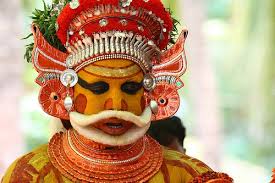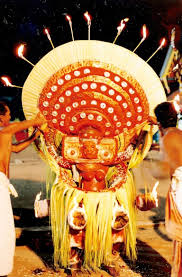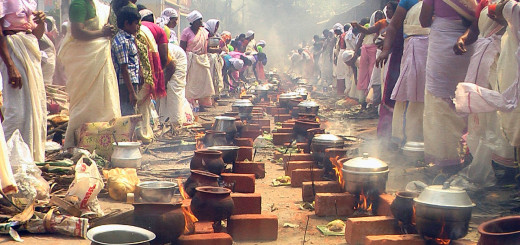Most popular Theyyams
There is a story behind every Theyyam. Each Theyyam is a man or a woman who attained divine status by performing heroic deeds or by leading a virtuous life. Sometimes they are virtuous souls who had been wronged.
Most Theyyams are believed to be the incarnations of Shiva or Shakti (the consort of Shiva). Or they have strong associations with these principal deities of Hinduism. A Theyyam not only tells the story of a deity, but also metamorphoses into that deity during the performance. This is what distinguishes Theyyam from other performing arts. A Theyyam is considered as a god.
There are over 400 theyyams. Some of these are very important. Here is an overview of the most famous theyyams.
Vishnumoorthi

Vishnumoorthi Theyyam
There are only two Vaishnava Theyyams – Daivatar and Vishnumoorthi. These Theyyams are believed to be the incarnations of Lord Vishnu. Complicated rites and rituals are associated with the Vishnumoorthi Theyyam. This Theyyam narrates the story of Palanthai Kannan who was a great devotee of Lord Vishnu.
Sree Muthappan Theyyam

Muthappan Theyyam
Muthappan Theyyam is performed throughout the year. Other Theyyams are only performed seasonally. There are numerous Muthappan temples in northern Kerala and each one has a story of its own. The most famous Muthappan temples are the ones at Parassini Kadavu and Kunnathur Padi. The rituals at Muthappan temples are performed by members of the Thiyya community.
Gulikan

Gulikan Theyyam Face
Gulikan is believed to be an incarnation of Yama, the Hindu god of death and justice. According to Indian mythology, Gulikan was one of the most important warriors of Lord Shiva. None, not even gods, dared to look at him. One day, Parvathi told Shiva that she was afraid of looking at Gulikan. This made Shiva furious. He turned towards Gulikan and threw him to the ground. This scene is sometimes enacted during the performance of the Gulikan Theyyam. The dance steps performed by the Gulikan Theyyam are very fascinating. The Gulikan Theyyam is an inevitable part of every Kaliyattam. Venganakavu Gulikan temple at Nileshwar is the most famous Gulikan temples in Kerala. There is a general belief is that the prosperity of this neighborhood is due to the blessings of Gulikan.
Padikutti Amma
Padikuttiyamma is thought to be the mother of Muthappan. She took great care of him for several years. She attained the status of a goddess when Muthappan became a god. The Theyyam Padikutti Amma is performed in the famous Palaprath Temple, at Kodallur. This place is near the Parassini Kadavu Muthappan temple. This Theyyam is performed in the Malayalam month of Meenam (March – April). Sree Padikkutti Mahadevi Temple at Eruvessi is famous.
Muthappan Anthithira
Muthappan Antithira is performed only once in all the Muthappan temples of North Malabar. The make-up of this Theyyam resembles that of Muthappan in the back and Vettakorumakan in the front.
Puthiya Bhagavathy
 There are several shrines dedicated to Puthiya Bhagavathi in Kannur. She is believed to have emerged from the homakunda (sacrificial fire) when rishis were performing a homa (sacrifice) to cure the smallpox of Lord Shiva. During performance, Puthiya Bhagavathi Theyyam is accompanied by Padakulangara Veeran Theyyam and Veerakali Theyyam. This Theyyam is performed in Koovapratthu Kaavu in Kavinisseri and in the Morazha Koorumba Kaavu in Pazhangottu.
There are several shrines dedicated to Puthiya Bhagavathi in Kannur. She is believed to have emerged from the homakunda (sacrificial fire) when rishis were performing a homa (sacrifice) to cure the smallpox of Lord Shiva. During performance, Puthiya Bhagavathi Theyyam is accompanied by Padakulangara Veeran Theyyam and Veerakali Theyyam. This Theyyam is performed in Koovapratthu Kaavu in Kavinisseri and in the Morazha Koorumba Kaavu in Pazhangottu.
Perum Kaliyattam
The Theyyam festival that is conducted at intervals of 12 or more years is known as Perum Kaliyattam (big Kaliyattam). Several Theyyams will perform during a Perum Kaliyattam. In 2008 several temples in Kannur celebrated Perum Kaliyattams. The next will most probably be in 2020.
Agni Kandakarnan

Agni Kandakarnan theyyam face
The performer of this Theyyam wears lighted torches attached to his waist. As you can imagine, this is a spectacular sight. This Theyyam is performed at Swamimadam in Kannu Veedu Kapadapuram, Valiyaparamapa Kasaragod in Kerala. This Theyyam is performed in the early morning in the Temple.
Padamadakki Bhagavathy
There is an interesting story behind this Theyyam. The king of Nileswar was a worried man because a troupe of invaders from Karnataka was marching towards his kingdom. He sought the help of Koroth Nāga Bhagavathy, Kuttichathan [Sasthappan] and Bhairavan. These gods sent Padamadakki Bhagavathy to save the king and his kingdom. Upon seeing the Padamadakki Bhagavathy, the invaders became unconscious and the battle was averted. This Theyyam is performed annually at the Koroth temple.
Manakott Amma
Manakott was a powerful Nair family in Nileswar. An educated young woman hailing from this family decided to challenge the caste system that was prevalent at that time. The Nair community belongs to the upper caste. While this woman was pregnant with a child, she broke the caste law by drinking water from a cup used by an outcast. The head of her family became furious when he heard of this incident and killed her. The murder of a woman who was pregnant with a child created several problems in their family. Eventually everyone in that family perished. The villagers later deified this woman as Manakkott Amma. Her Theyyam is performed annually in April at the Vairajathan Temple, in Nileshwar.
Kuttichathan

Kuttichathan-theyyam-face
Kuttichathan is a famous deity and the Kuttichathan Theyyam is also hugely popular. There is an interesting story about Kuttichathan. Once upon a time, Shiva and Parvathi lived in a remote hill area with the ‘Valluvar’ community. They had two children named Karuval and Kuttichathan. Kuttichathan was born with a flower on his forehead, a third eye and a black body with white stripes. A Brahmin couple lived nearby and they didn’t have any children. They observed prolonged fasting to appease Shiva. Pleased with their devotion, the Lord decided to give Kuttichathan to the couple. Even as a child, Kuttichathan was into mischief. He would never listen to the elders. He would even behead the cows and drink their blood. These acts distressed his adoptive parents and they killed him. But even after his death, they could not get rid of him. They would constantly hear his voice reverberating inside their Illam (a Brahmin household). To eliminate these disturbances, the distressed couple organized a puja. They created a fire pit but to their utter shock, they found several Kuttichathans emerging from the fire. These Chathans started performing fire dance and destroyed the Illam. The Brahmin couple realized that the child was divine and constructed shrines called ‘Sthanas’ for him. There are several Kuttichathans. The most popular ones are Poo Kuttichathan (flower Kuttichathan), Karim Kuttichathan (black Kuttichathan) and Thee Kuttichathan (fire Kuttichathan). Devotees believe that Kuttichathan will fulfill their wishes if they make him happy through sincere prayers.
Kathivanur Veeran

Kathivanur Veeran Theyyam face
The Theyyam Kathivanur Veeran is performed in honor of Mandhappan who was a great warrior. He was born in a Thiyya family in Thaliparamba. As a young man Mandhappan was rather irresponsible. He would waste his time playing silly games. This made his father angry and one day he threw Mandhappan out of his home.
Mandhappan left his village and went to Coorg where his uncle lived. His uncle was happy to receive him and even gave him half of his property. Mandhappan then married a girl called Chemmarathi. At around that time, Coorg was attacked by Kutakas. Mandhappan and his friends fought bravely and they drove the enemies away. Unfortunately he lost a finger in the battle with his wedding ring on it. When he realized that he had lost his ring, he returned to the battlefield to look for it. The enemies saw him coming alone and killed him. Chemmarathi was heartbroken. She immolated herself by jumping into his funeral pyre. Mandhappan was later deified as Kathivanur Veeran. The performer of this Theyyam need expertise in the martial art form of Kalaripayattu.
Pottan Theyyam

Pottan Theyyam face
Pottan Theyyam wears vivid, colorful costumes and make-up. Pottan is believed to have originated from Lord Shiva. In some Hindu households, Pottan Theyyam has a small hut dedicated to him. Pottan is a symbol of goodness that can wipe out social evils.
Muchilot Bhagavathi

Muchilottu Bhagavathi theyyam pooram
Muchilot Bhagavathi is the source of immense knowledge and prosperity. There are several stories about her. Some believe that she emerged from the sweat of Lord Shiva while he was performing his celestial dance Thandava. According to another more popular story, she was a Brahmin virgin who possessed a thorough understanding of Vedas. None could match her expertise in darting arguments and counter arguments. One day Peringellur Mootha Gurukkal, a well-read Brahmin and his disciplines, challenged the Naduvazhi (local ruler) to beat them in a discussion about the Vedas. The Naduvazhi sought the help of this Brahmin girl. Her arguments and counter arguments stunned the Gurukkal and he became envious of her. When it became clear that they were going to lose, they decided to trap her somehow.
They asked her two questions: What is the most excruciating pain? What is the greatest pleasure? The Brahmin girl could not see through their deceptive strategy. To the first question she innocently replied ‘labor pain’ and to the second question she replied ‘erotic pleasure’. This is exactly what they wanted to hear. The Gurukkal asked her how she could give these answers with such conviction. She being a virgin couldn’t have known either. They claimed that she was not a virgin. This eventually led to her excommunication. The grief stricken girl immolated herself. Shiva sent her soul back to earth with some boons, various weapons, a golden fan and jewelry to redeem the world. This Brahmin girl was eventually deified as Sree Muchilot Bhagavathi.


